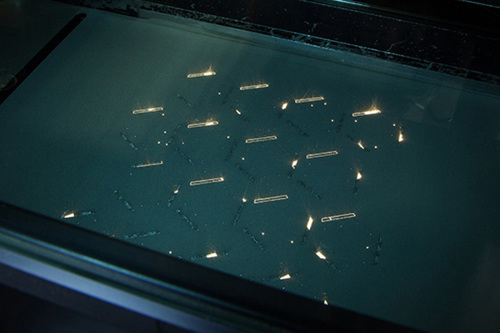Titanium (Ti6Al4V) 3D Printing
Titanium is a lightweight metal with high strength and excellent corrosion resistance

Titanium (Ti6Al4V) is a workhorse alloy. Versus Ti grade 23 annealed, the mechanical properties of Ti6Al4V are comparable to wrought titanium for tensile strength, elongation, and hardness. Final parts built in Ti6Al4V receive vacuum stress relief application.
Primary Benefits
- High stiffness and strength relative to weight
- High temperature and corrosion resistance
Design Guidelines for Titanium 3D Printing
| Normal Resolution | High Resolution | |
|---|---|---|
| Max Part Size | 9.6 in. x 9.6 in. x 13.0 in. | 3.5 in. x 3.5 in. x 2.7 in. |
| Layer Thickness | 0.0012 in. | 0.00079 in. |
| Minimum Feature Size | 0.015 in. | 0.006 in. |
| Normal Resolution | High Resolution | |
|---|---|---|
| Max Part Size | 245mm x 245mm x 330mm | 88mm x 88mm x 70mm |
| Layer Thickness | 30 microns | 20 microns |
| Minimum Feature Size | 0.381mm | 0.153mm |
Tolerances: For well-designed parts, tolerances of ±0.003 in(0.076mm) plus ±0.001 in./in. (0.0254mm/mm) can typically be achieved. Note that tolerances may change depending on part geometry.

Titanium (Ti6Al4V) Material Properties
|
|
Resolution | Condition | Ultimate Tensile Strength | Yield Stress | Elongation | Hardness |
|---|---|---|---|---|---|---|
| Titanium (Ti6Al4V) |
20 μm | Stress Relieved | 153 ksi | 138 ksi | 15% | 35 HRC |
| 30 μm | Stress Relieved | 144 ksi | 124 ksi | 18% | 33 HRC |
|
|
Resolution | Condition | Ultimate Tensile Strength | Yield Stress | Elongation | Hardness |
|---|---|---|---|---|---|---|
| Titanium (Ti6Al4V) |
20 μm | Stress Relieved | 1055 Mpa | 951 Mpa | 15% | 35 HRC |
| 30 μm | Stress Relieved | 993 Mpa | 855 Mpa | 18% | 33 HRC |
Applications for 3D-Printed Titanium
Due to its light weight, high strength, and excellent high temperature and corrosion resistance, titanium is often used for aerospace, industrial, and medical applications. Common uses include:
- Compressor blades and discs
- Rings for jet engines
- Airframe and space capsule components
- Surgical instruments
- Medical implants










